2012 PEUGEOT 308 weight
[x] Cancel search: weightPage 204 of 328

202
PRACTICAL INFORMATION
TOWING A TRAILER,
A CARAVAN, ETC.
Your vehicle is primarily designed for
transporting people and luggage, but it
may also be used for towing a trailer.
Driving advice
The maximum towed load on a long in-
cline depends on the gradient and the
ambient temperature.
In all cases, keep a check on the cool-
ant temperature.
Side wind
�)
Take into account the increased
sensitivity to side wind.
Cooling
Towing a trailer on a slope increases
the temperature of the coolant.
As the fan is electrically controlled, its
cooling capacity is not dependent on
the engine speed.
�)
To lower the engine speed, reduce
your speed.
Braking
Towing a trailer increases the braking
distance.
To avoid overheating of the brakes on a
long mountain type of descent, the use
of engine braking is recommended.
Tyres
�)
Check the tyre pressures of the towing
vehicle and of the trailer, observing the
recommended pressures.
Lighting
�)
Check the electrical lighting and sig-
nalling on the trailer.
The rear parking sensors will
be deactivated automatically if
a genuine PEUGEOT towbar
is used.
�)
If the warning lamp and the
STOP
warning lamp come
on, stop the vehicle and
switch off the engine as
soon as possible.
Towbar suitable for the attachment of a
trailer or caravan with additional lighting
and signalling.
Distribution of loads
�)
Distribute the load in the trailer so
that the heaviest items are as close
as possible to the axle and the nose
weight approaches the maximum
permitted without exceeding it.
Air density decreases with altitude, thus
reducing engine performance. Above
1 000 metres, the maximum towed load
must be reduced by 10 % for every
1 000 metres of altitude. Driving with a trailer places greater de-
mands on the towing vehicle and the
driver must take particular care.
We recommend the use of
genuine PEUGEOT towbars
and their harnesses that have
been tested and approved from the
design stage of your vehicle, and that
the fi tting of the towbar is entrusted
to a PEUGEOT dealer or a qualifi ed
workshop.
If the towbar is not fi tted by a
PEUGEOT dealer, it is imperative
that it is fi tted in accordance with the
vehicle manufacturer's instructions. Refer to the "Technical Data"
section for details of the
weights and towed loads
which apply to your vehicle.
Page 205 of 328
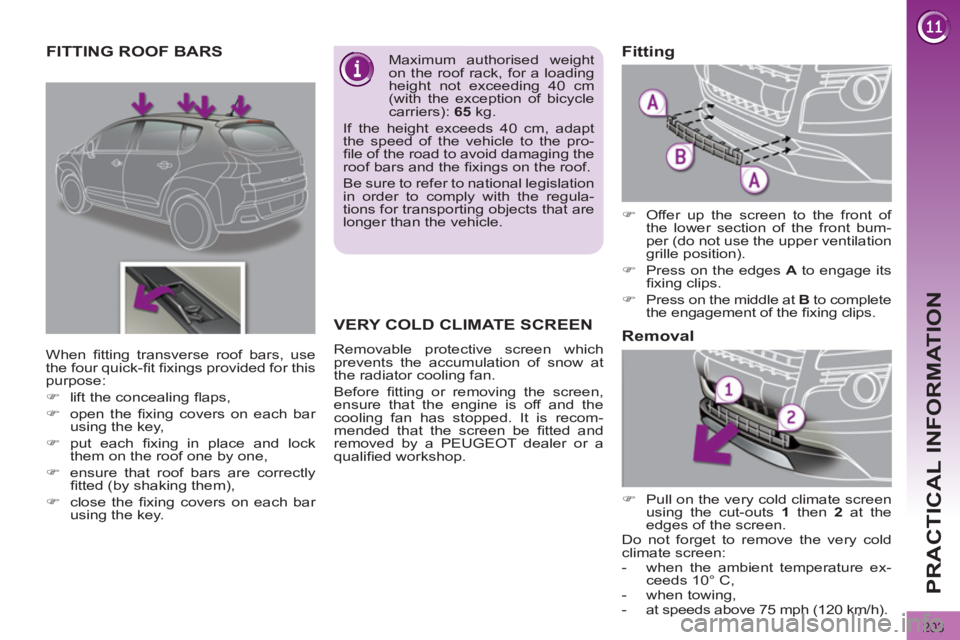
203
PRACTICAL INFORMATION
FITTING ROOF BARS
Maximum authorised weight
on the roof rack, for a loading
height not exceeding 40 cm
(with the exception of bicycle
carriers): 65
kg.
If the height exceeds 40 cm, adapt
the speed of the vehicle to the pro-
fi le of the road to avoid damaging the
roof bars and the fi xings on the roof.
Be sure to refer to national legislation
in order to comply with the regula-
tions for transporting objects that are
longer than the vehicle.
When fi tting transverse roof bars, use
the four quick-fi t fi xings provided for this
purpose:
�)
lift the concealing fl aps,
�)
open the fi xing covers on each bar
using the key,
�)
put each fi xing in place and lock
them on the roof one by one,
�)
ensure that roof bars are correctly
fi tted (by shaking them),
�)
close the fi xing covers on each bar
using the key.
VERY COLD CLIMATE SCREEN
Removable protective screen which
prevents the accumulation of snow at
the radiator cooling fan.
Before fi tting or removing the screen,
ensure that the engine is off and the
cooling fan has stopped. It is recom-
mended that the screen be fi tted and
removed by a PEUGEOT dealer or a
qualifi ed workshop.
�)
Offer up the screen to the front of
the lower section of the front bum-
per (do not use the upper ventilation
grille position).
�)
Press on the edges A
to engage its
fi xing clips.
�)
Press on the middle at B
to complete
the engagement of the fi xing clips.
Fitting
�)
Pull on the very cold climate screen
using the cut-outs 1
then 2
at the
edges of the screen.
Do not forget to remove the very cold
climate screen:
- when the ambient temperature ex-
ceeds 10° C,
- when towing,
- at speeds above 75 mph (120 km/h).
Removal
Page 208 of 328
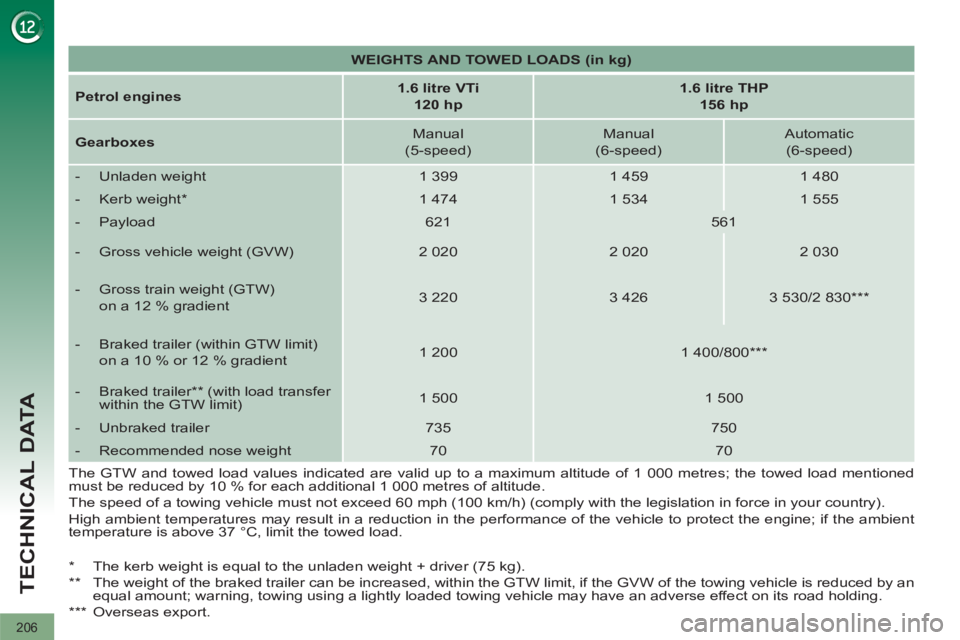
206
TECHNICAL DATA
WEIGHTS AND TOWED LOADS (in kg)
Petrol engines
1.6 litre VTi
120 hp
1.6 litre THP
156 hp
Gearboxes
Manual
(5-speed)
Manual
(6-speed)
Automatic
(6-speed)
- Unladen weight
1 399
1 459
1 480
- Kerb weight *
1 474
1 534
1 555
- Payload
621
561
- Gross vehicle weight (GVW)
2 020
2 020
2 030
- Gross train weight (GTW)
on a 12 % gradient
3 220
3 426
3 530/2 830 ***
- Braked trailer (within GTW limit)
on a 10 % or 12 % gradient
1 200
1 400/800 ***
- Braked trailer ** (with load transfer
within the GTW limit)
1 500
1 500
- Unbraked trailer
735
750
- Recommended nose weight
70
70
The GTW and towed load values indicated are valid up to a maximum altitude of 1 000 metres; the towed load mentioned
must be reduced by 10 % for each additional 1 000 metres of altitude.
The speed of a towing vehicle must not exceed 60 mph (100 km/h) (comply with the legislation in force in your country).
High ambient temperatures may result in a reduction in the performance of the vehicle to protect the engine; if the ambient
temperature is above 37 °C, limit the towed load.
* The kerb weight is equal to the unladen weight + driver (75 kg).
** The weight of the braked trailer can be increased, within the GTW limit, if the GVW of the towing vehicle is reduced by an
equal amount; warning, towing using a lightly loaded towing vehicle may have an adverse effect on its road holding.
***
Overseas export.
Page 210 of 328
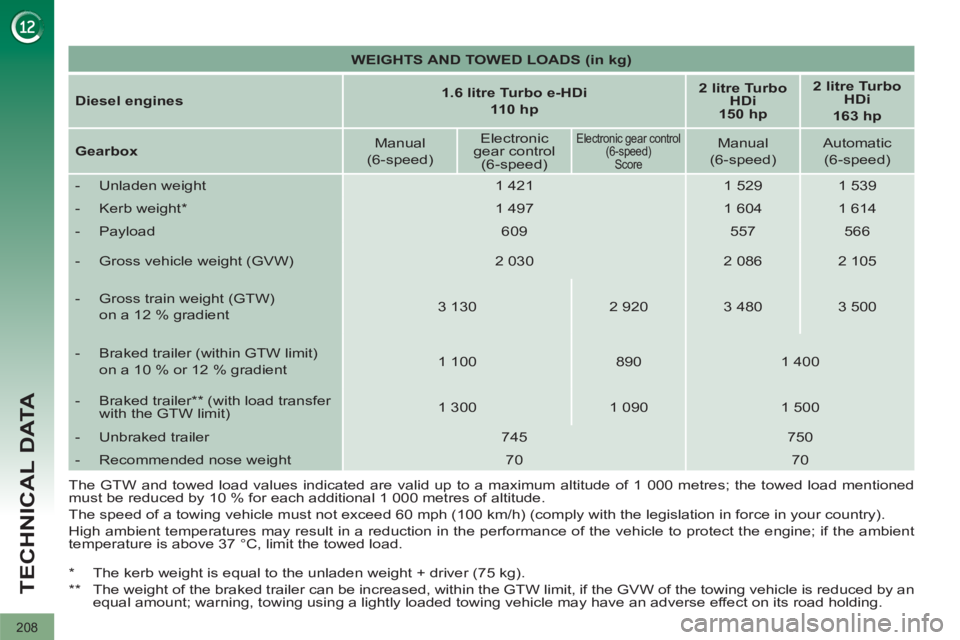
208
TECHNICAL DATA
WEIGHTS AND TOWED LOADS (in kg)
Diesel engines
1.6 litre Turbo e-HDi
110 hp
2 litre Turbo
HDi
150 hp
2 litre Turbo
HDi
163 hp
Gearbox
Manual
(6-speed)
Electronic
gear control
(6-speed)
Electronic gear control
(6-speed)
Score
Manual
(6-speed)
Automatic
(6-speed)
- Unladen weight
1 421
1 529
1 539
- Kerb weight *
1 497
1 604
1 614
- Payload
609
557
566
- Gross vehicle weight (GVW)
2 030
2 086
2 105
- Gross train weight (GTW)
on a 12 % gradient
3 130
2 920
3 480
3 500
- Braked trailer (within GTW limit)
on a 10 % or 12 % gradient
1 100
890
1 400
- Braked trailer ** (with load transfer
with the GTW limit)
1 300
1 090
1 500
- Unbraked trailer
745
750
- Recommended nose weight
70
70
The GTW and towed load values indicated are valid up to a maximum altitude of 1 000 metres; the towed load mentioned
must be reduced by 10 % for each additional 1 000 metres of altitude.
The speed of a towing vehicle must not exceed 60 mph (100 km/h) (comply with the legislation in force in your country).
High ambient temperatures may result in a reduction in the performance of the vehicle to protect the engine; if the ambient
temperature is above 37 °C, limit the towed load.
* The kerb weight is equal to the unladen weight + driver (75 kg).
**
The weight of the braked trailer can be increased, within the GTW limit, if the GVW of the towing vehicle is reduced by an
equal amount; warning, towing using a lightly loaded towing vehicle may have an adverse effect on its road holding.
Page 211 of 328

209
TECHNICAL DATA
WEIGHTS AND TOWED LOADS 3008 LCV (in kg)
Engines
1.6 litre Turbo e-HDi
110 hp
2 litre Turbo HDi
150 hp
Gearbox
es
Manual
(6-speed)
Electronic gear control
(6-speed) Score
Electronic gear control
(6-speed)
Manual
(6-speed)
Model codes
9HZ
9HR
9HZ
RHE
- Unladen weight
1 434
1 430
1 538
- Kerb weight *
1 509
1 505
1 613
- Gross vehicle weight (GVW) **
2 150
2 135
2 239
- Gross train weight (GTW)
on a 12 % gradient ***
3 120
2 920
3 130
3 480
- Braked trailer (within GTW limit)
on a 10 % or 12 % gradient ****
970
770
995
1 241
- Braked trailer (with load transfer
with the GTW limit)
X
X
X
X
- Unbraked trailer
750
750
- Recommended nose weight
70
70
* The kerb weight is equal to the unladen weight + driver (75 kg).
**
Exceeding the maximum rear axle weight involves a speed restriction of 50 mph (80 km/h) as defi ned in point 2.7 of the
Directive.
***
Exceeding the gross vehicle weight when the vehicle is towing involves a speed restriction of 50 mph (80 km/h) as defi ned
in point 2.7 of the Directive.
****
Maximum braked trailer weight, within the GTW limit; warning, towing using a lightly loaded towing vehicle may have an
adverse effect on its road holding.
The GTW and towed load values indicated are valid up to a maximum altitude of 1 000 metres; the towed load mentioned
must be reduced by 10 % for each additional 1 000 metres of altitude.
High ambient temperatures may result in a reduction in the performance of the vehicle to protect the engine; if the ambient
temperature is above 37 °C, limit the towed load.
Page 320 of 328
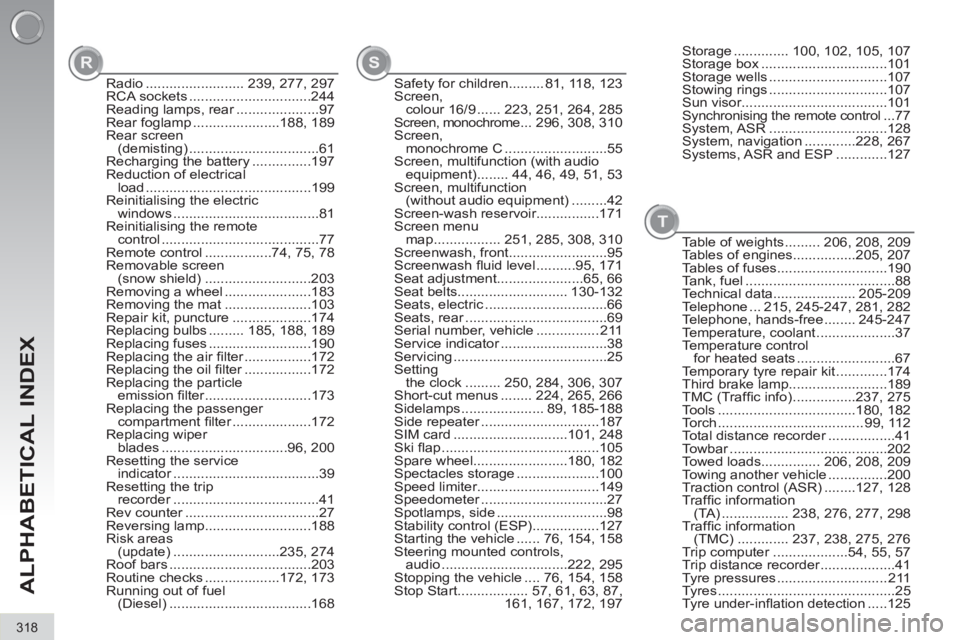
318
ALPHABETICAL INDEX
SRStorage .............. 100, 102, 105, 107
Storage box ................................101
Storage wells ..............................107
Stowing rings ..............................107
Sun visor.....................................101
Synchronising the remote control ...77
System, ASR ..............................128
System, navigation .............228, 267
Systems, ASR and ESP .............127 Safety for children......... 81, 118, 123
Screen,
colour 16/9 ...... 223, 251, 264, 285
Screen, monochrome ... 296, 308, 310
Screen,
monochrome C ..........................55
Screen, multifunction (with audio
equipment) ........ 44, 46, 49, 51, 53
Screen, multifunction
(without audio equipment) .........42
Screen-wash reservoir................171
Screen menu
map ................. 251, 285, 308, 310
Screenwash, front.........................95
Screenwash fl uid level ..........95, 171
Seat adjustment......................65, 66
Seat belts............................ 130-132
Seats, electric ...............................66
Seats, rear ....................................69
Serial number, vehicle ................ 211
Service indicator ...........................38
Servicing .......................................25
Setting
the clock ......... 250, 284, 306, 307
Short-cut menus ........ 224, 265, 266
Sidelamps ..................... 89, 185-188
Side repeater ..............................187
SIM card .............................101, 248
Ski fl ap ........................................105
Spare wheel........................180, 182
Spectacles storage .....................100
Speed limiter...............................149
Speedometer ................................27
Spotlamps, side ............................98
Stability control (ESP).................127
Starting the vehicle ...... 76, 154, 158
Steering mounted controls,
audio ................................222, 295
Stopping the vehicle .... 76, 154, 158
Stop Start.................. 57, 61, 63, 87,
161, 167, 172, 197 Radio ......................... 239, 277, 297
RCA sockets ...............................244
Reading lamps, rear .....................97
Rear foglamp ......................188, 189
Rear screen
(demisting) .................................61
Recharging the battery ...............197
Reduction of electrical
load ..........................................199
Reinitialising the electric
windows .....................................81
Reinitialising the remote
control ........................................77
Remote control .................74, 75, 78
Removable screen
(snow shield) ...........................203
Removing a wheel ......................183
Removing the mat ......................103
Repair kit, puncture ....................174
Replacing bulbs ......... 185, 188, 189
Replacing fuses ..........................190
Replacing the air fi lter .................172
Replacing the oil fi lter .................172
Replacing the particle
emission fi lter ...........................173
Replacing the passenger
compartment fi lter ....................172
Replacing wiper
blades ................................96, 200
Resetting the service
indicator .....................................39
Resetting the trip
recorder .....................................41
Rev counter ..................................27
Reversing lamp...........................188
Risk areas
(update) ...........................235, 274
Roof bars ....................................203
Routine checks ...................172, 173
Running out of fuel
(Diesel) ....................................168
T
Table of weights ......... 206, 208, 209
Tables of engines................205, 207
Tables of fuses............................190
Tank, fuel ......................................88
Technical data..................... 205-209
Telephone ... 215, 245-247, 281, 282
Telephone, hands-free ........ 245-247
Temperature, coolant ....................37
Temperature control
for heated seats .........................67
Temporary tyre repair kit .............174
Third brake lamp.........................189
TMC (Traffi c info) ................237, 275
Tools ...................................180, 182
Torch ..................................... 99, 112
Total distance recorder .................41
Towbar ........................................202
Towed loads............... 206, 208, 209
Towing another vehicle ...............200
Traction control (ASR) ........127, 128
Traffi c information
(TA) ................. 238, 276, 277, 298
Traffi c information
(TMC) ............. 237, 238, 275, 276
Trip computer ...................54, 55, 57
Trip distance recorder ...................41
Tyre pressures ............................ 211
Tyres .............................................25
Tyre under-infl ation detection .....125
Page 321 of 328
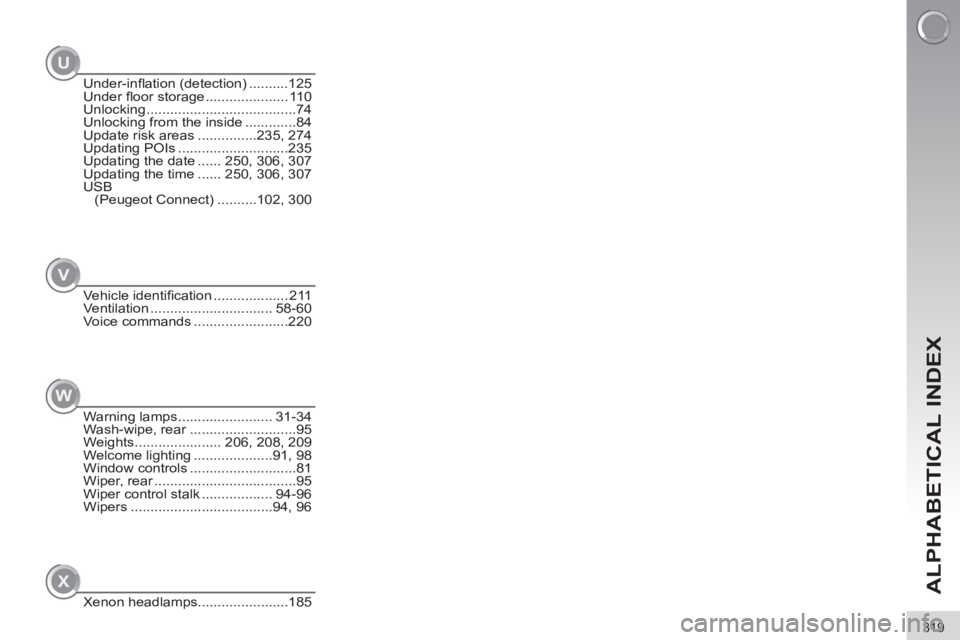
319
ALPHABETICAL INDEX
U
V
W
X
Under-infl ation (detection) ..........125
Under fl oor storage ..................... 110
Unlocking ......................................74
Unlocking from the inside .............84
Update risk areas ...............235, 274
Updating POIs ............................235
Updating the date ...... 250, 306, 307
Updating the time ...... 250, 306, 307
USB
(Peugeot Connect) ..........102, 300
Vehicle identifi cation ................... 211
Ventilation ............................... 58-60
Voice commands ........................220
Warning lamps ........................ 31-34
Wash-wipe, rear ...........................95
Weights ...................... 206, 208, 209
Welcome lighting ....................91, 98
Window controls ...........................81
Wiper, rear ....................................95
Wiper control stalk .................. 94-96
Wipers ....................................94, 96
Xenon headlamps.......................185
Page 326 of 328

324
VISUAL SEARCH
TECHNICAL DATA - MAINTENANCE
Identifi cation markings ................ 211
Running out of fuel, Diesel ......... 168
Checking levels ................... 171-172
- oil
- brake fl uid
- power steering fl uid
- coolant
- screenwash/headlamp wash fl uid
Checking components ......... 172-173
- air fi lter
- passenger compartment fi lter
- oil fi lter
- brake pads/discs
Changing bulbs.................... 185-189
- front
- rear
12 V battery ......................... 197-198
Load reduction, economy mode .... 199
Engine compartment
fuses ......................... 190, 194-196
Opening the bonnet .................... 167
Under the bonnet, petrol ............. 169
Under the bonnet, Diesel ............ 170
Petrol engines............................. 205
Diesel engines ............................ 207
Dimensions ................................. 210
Petrol weights ............................. 206
Diesel weights ............................ 208
Diesel LCV weights .................... 209